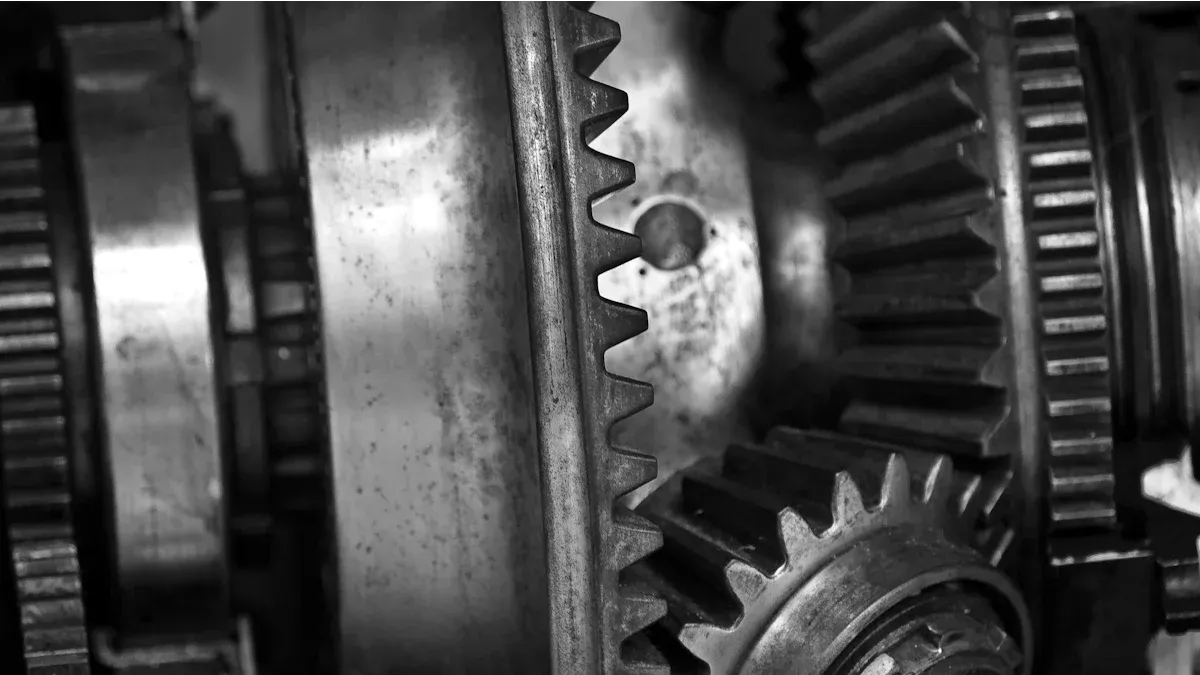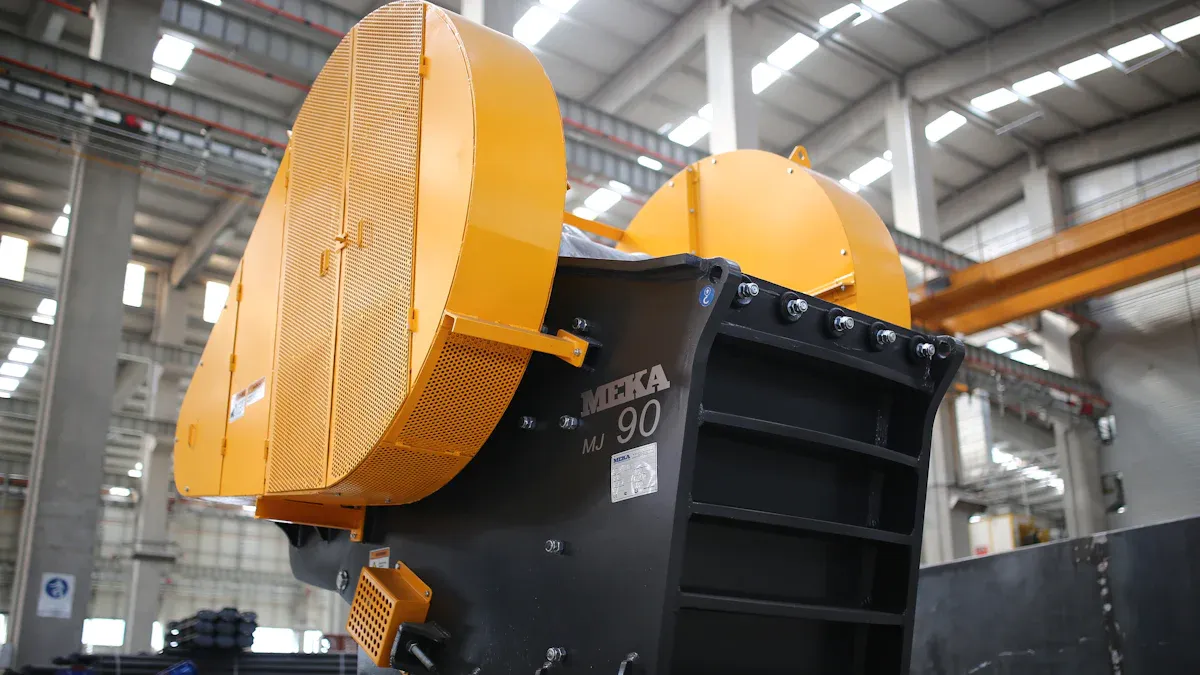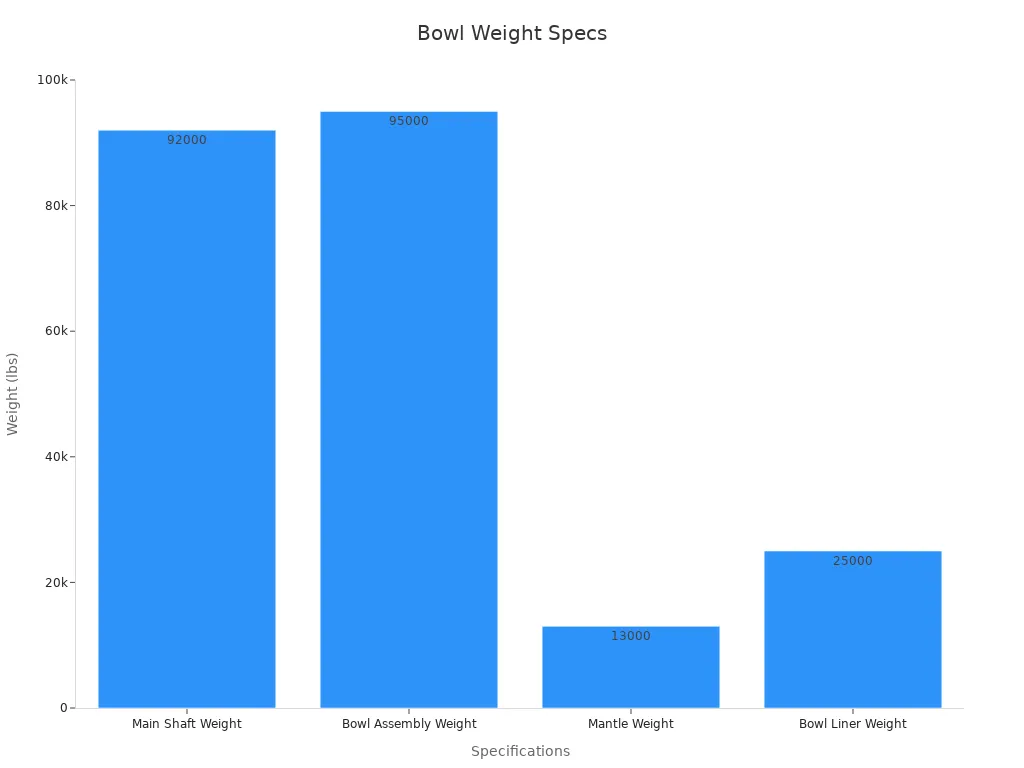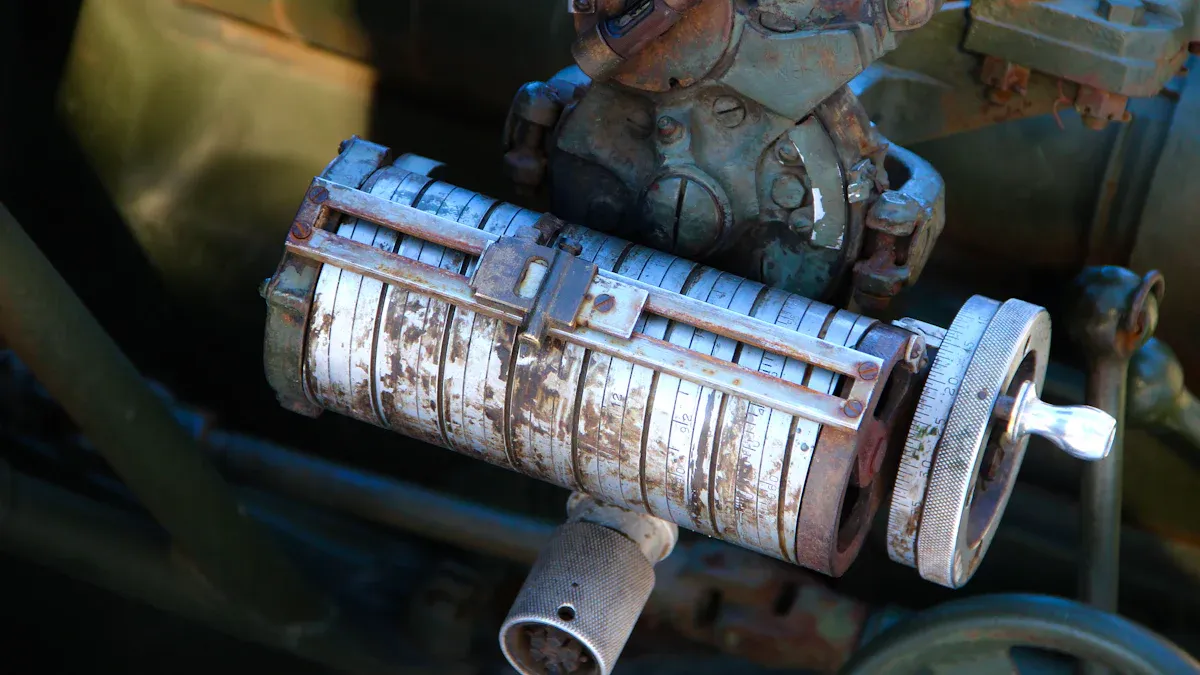
The bowl and mantle in a cone crusher work together to break down materials into smaller pieces. The mantle rotates within the stationary bowl, creating pressure to crush the material through compression and shearing forces. This mechanism handles heavy loads efficiently and produces consistent material sizes. For example, some cone crushers can process up to 3,200 tons per hour, depending on the bowl and mantle size. Modern designs also improve energy efficiency by up to 30% and extend wear part lifespan, reducing operational costs. T hese components are essential for reliable and effective material crushing.

The bowl in a cone crusher is a stationary component that plays a critical role in the crushing process. It forms the outer shell of the crushing chamber and works in tandem with the mantle to break down materials. The bowl assembly supports a concave structure, which helps guide the material into the crushing zone. Material is choke-fed into the top of the bowl, ensuring consistent p ressure and efficient crushing.
Key specifications of the bowl include its weight and material composition. For example, the bowl assembly typically weighs around 95,000 lbs, while the bowl liner weighs approximately 25,000 lbs. Both are cast from durable manganese steel to withstand the intense forces of crushing. The bowl also features an adjustment mechanism, allowing you to modify the closed side setting (CSS) during operation for precise output sizes. Additionally, it includes a vertical lift system to handle uncrushable objects, preventing damage to the crusher.

The mantle is the moving part of the cone crusher that rotates eccentrically to crush materials. Shaped like a lampshade, it connects to the motor and moves within the stationary bowl. This motion generates the necessary crushing force, breaking down materials into smaller pieces. The mantle’s design directly impacts the efficiency and wear patterns of the crusher.
Manufactured from high-strength materials, the mantle is built to endure extreme stress. Common materials include high manganese steel, which is wear-resistant and work-hardens under pressure, and chromium steel, known for its hardness and toughness. The mantle’s alignment with the bowl ensures effective crushing and smooth material flow through the crusher. Optimizing the design of the crushing chamber, where the mantle operates, can further enhance efficiency and reduce wear.

The bowl and mantle in a cone crusher work together to crush materials through two primary forces: compression and shearing. When material enters the crushing chamber, the mantle moves eccentrically against the stationary bowl. This movement compresses the material between the two surfaces, breaking it into smaller pieces. Shearing occurs as the mantle scrapes against the material, further reducing its size. These combined forces ensure efficient crushing and consistent output.
Studies show that optimizing the interaction between the mantle and bowl can significantly enhance crushing efficiency. For example:
- The time required to break particle bonds decreases, improving productivity.
- The maximum crushing force increases, leading to better performance.
- Even loading of the moving cone improves mechanical durability and extends the crusher's lifespan.
By understanding these forces, you can better appreciate how the cone crusher achieves its high efficiency and reliability.
The bowl remains stationary while the mantle rotates within it. This unique movement pattern is key to the cone crusher's functionality. The stationary bowl provides a stable surface for the material to press against, while the rotating mantle creates the necessary force to crush it. The mantle's eccentric motion ensures that the material is crushed evenly throughout the chamber.
This design also allows the cone crusher to handle a wide range of materials, from soft to hard rocks. The rotating mantle and stationary bowl work in harmony to deliver consistent results, even under heavy loads. This movement pattern not only enhances crushing efficiency but also minimizes wear on the mantle and concaves, reducing maintenance needs.
The gap between the bowl and mantle determines the size of the crushed material. You can adjust this gap, known as the closed side setting (CSS), to achieve the desired output size. A smaller gap produces finer material, while a larger gap results in coarser output. This flexibility makes the cone crusher suitable for various applications, from producing fine aggregates to processing larger rocks.
Modern cone crushers feature hydraulic adjustment systems, allowing you to modify the gap quickly and precisely. This ensures consistent material size and quality, even as the mantle and bowl liners wear over time. Regularly monitoring and adjusting the gap can help you maintain optimal performance and extend the life of your crusher.
Cone crusher liners play a vital role in maintaining consistent material size and quality during the crushing process. These liners, which cover the bowl and mantle, ensure that materials are crushed uniformly. This uniformity is essential for producing high-quality aggregates and meeting industry standards.
To achieve this consistency, you must focus on routine maintenance and timely replacement of worn liners. Regular inspections prevent premature wear and ensure the crusher operates efficiently. Replacing worn parts, such as the liners, helps maintain optimal performance and prevents uneven crushing. Additionally, modern cone crushers allow real-time monitoring of liner wear. This feature enables you to make dynamic adjustments based on material characteristics, improving both throughput and output quality.
Tip: Optimizing your equipment settings based on the type of material being processed can increase productivity and reduce energy consumption.
By prioritizing the upkeep of cone crusher liners, you can ensure consistent material size and quality, which is critical for various applications, from construction to mining.
Optimized cone crusher liners significantly impact throughput and operational costs. When liners are in good condition, they enhance the crusher's efficiency, allowing it to process more material in less time. This increased throughput directly translates to higher productivity.
Industry reports highlight that advanced liners, such as MX crusher liners, can last 20-25% longer. This durability reduces the frequency of replacements, saving you time and money. Furthermore, improvements in energy efficiency, ranging from 10-30%, lower the overall operational costs of mining machinery, including cone crushers.
Using high-quality liners also minimizes downtime caused by maintenance or unexpected failures. This reliability ensures that your operations run smoothly, maximizing profitability. By investing in durable and efficient liners, you can achieve substantial cost savings while maintaining high performance.
The durability and wear resistance of cone crusher liners are crucial for their performance and longevity. These liners are exposed to extreme forces and abrasive materials, making their construction critical. High manganese steel is commonly used for liners due to its ability to withstand intense pressure and wear. This material also work-hardens under stress, further enhancing its durability.
Durable liners reduce the need for frequent replacements, saving you both time and resources. They also ensure that the crusher operates at peak efficiency, even under heavy loads. Wear-resistant liners maintain their shape and functionality over time, providing consistent crushing performance.
Note: Choosing high-quality liners not only improves durability but also reduces the risk of unexpected breakdowns, ensuring uninterrupted operations.
By selecting liners with superior wear resistance, you can extend the lifespan of your cone crusher and maintain its efficiency, even in demanding conditions.
Regular inspections help you identify wear patterns and potential issues with your cone crusher liners. Monitoring wear ensures that the mantle and bowl maintain their alignment, which is critical for consistent performance. You can use tools like ultrasonic thickness gauges to measure liner wear accurately. These measurements allow you to plan replacements before excessive wear impacts crushing efficiency.
Frequent checks also prevent unexpected downtime. For example, identifying uneven wear early can help you avoid costly repairs. By scheduling inspections, you ensure that your cone operates smoothly and delivers optimal results.
Tip: Create a maintenance log to track wear trends over time. This helps you predict when liners need replacement and reduces the risk of operational delays.
Installing and aligning cone crusher liners correctly is essential for maximizing their performance. Misaligned liners can cause uneven crushing, leading to inconsistent material sizes and increased wear. During installation, ensure that the mantle fits securely within the bowl and that all components are properly tightened.
Modern cone designs simplify this process. For instance, some crushers feature enhanced design elements that reduce installation time and improve safety. A case study on Nordberg HP4 crushers showed that maintenance tasks, including liner changes, could be completed in under five minutes. This efficiency reduces labor costs and minimizes downtime.
P roper alignment also improves energy efficiency. When the mantle and bowl are correctly positioned, the crusher requires less power to operate, lowering operational costs.
Investing in high-quality replacement parts ensures long-term performance and cost savings. Quality assessments, such as monitoring the Cost of Quality (CoQ), help you identify the best liners for your cone crusher. High-quality liners reduce defect rates and minimize costs associated with poor quality, such as rework and warranty claims.
Here’s how quality replacement parts impact operational efficiency:
Lower Defect Rates: Durable liners reduce the need for frequent replacements.
Reduced Costs of Poor Quality (COPQ): Expenses from scrap and rework decrease.
Improved Brand Reputation: Reliable parts enhance your crusher’s performance and maintain consiste nt output.
A table summarizing operational benefits highlights the importance of investing in quality liners:
| Evidence Type | Description |
|---|---|
| Enhanced Design Features | Smart designs reduce maintenance downtime and improve safety. |
| Reduced Maintenance Downtime | Tasks that took an hour now take less than five minutes. |
| Improved Safety Measures | Safer liner changes eliminate the need for backing material curing. |
| Increased Productivity | Transitioning to shorter shifts improves energy efficiency. |
| Cost Reduction | Lower labor costs due to increased efficiency and shorter operational hours. |
By choosing high-quality replacement parts, you enhance your cone crusher’s performance, reduce operational costs, and ensure consistent material quality.
The bowl and mantle in a cone crusher work together to deliver efficient and consistent crushing. The mantle rotates within the stationary bowl, applying compression and shearing forces to break down materials. This interaction ensures reliable performance and uniform material size.
Their critical role in crushing efficiency depends on proper maintenance and optimization. Regular inspections, precise gap adjustments, and high-quality liners help you maximize their lifespan and performance. Modern cone designs also offer advanced features like adaptive control systems, which enhance flexibility and safety.
Here’s a quick comparison of performance benchmarks for cone crushers:
| Metric | Description |
|---|---|
| High efficiency | Optimal energy consumption with higher output. |
| Robust design | Increased reliability and reduced maintenance. |
| Adaptive control system | Enhanced operational flexibility. |
| Efficiency ratings | Outperforms traditional crushers in energy use. |
| Operational advantages | Reduced wear, faster processing, improved safety. |
By focusing on these aspects, you can ensure your cone crusher operates at peak efficiency, delivering consistent results for your projects.
Cone crushers can handle a wide range of materials, including granite, limestone, and basalt. They are also effective for processing ores and recycled materials. This versatility makes them essential crushing equipment in mining, construction, and aggregate production.
You can adjust the output size by modifying the gap between the bowl and mantle. Modern cone crushers feature hydraulic systems that allow quick and precise adjustments, ensuring consistent material size and quality.
Regular maintenance ensures optimal performance and extends the lifespan of your crushing equipment. Inspections help identify wear patterns, allowing you to replace liners or other parts before they fail. This reduces downtime and operational costs.
Cone crushers use advanced designs that optimize energy consumption. Features like hydraulic adjustment systems and adaptive control technology reduce power usage while maintaining high throughput. This efficiency lowers operational costs and improves productivity.
Consider factors like material type, desired output size, and production capacity. Evaluate the crusher's features, such as liner durability and energy efficiency. Consulting with a crushing equipment expert can help you make the best choice for your application.